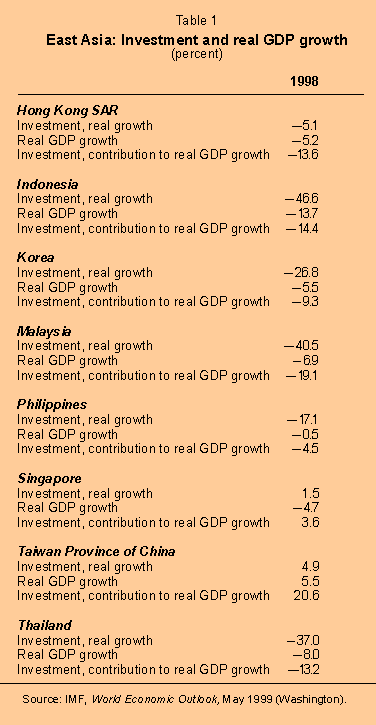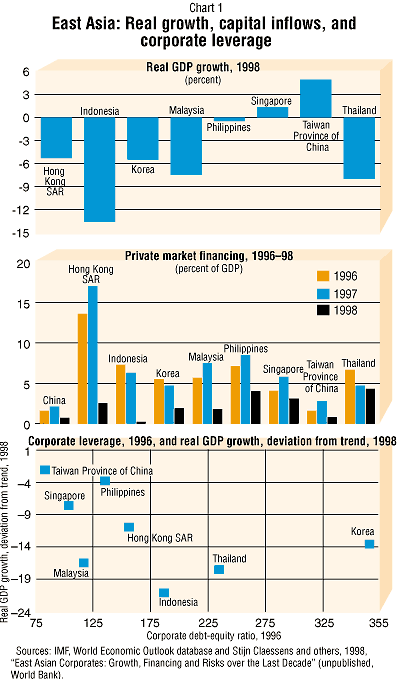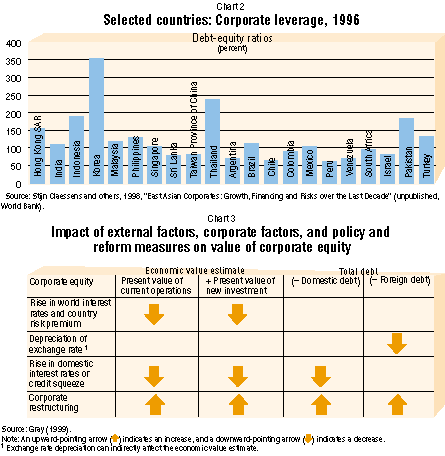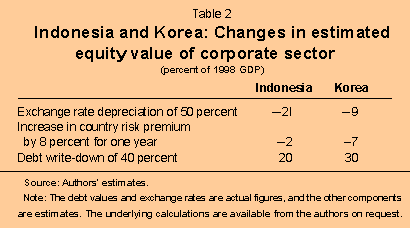 About F&D Subscribe Back Issues Write Us Copyright Information Use the free Adobe Acrobat Reader to view a pdf file of this article
|
Corporate Balance Sheets and Macroeconomic Policy Dale F. Gray and Mark R. Stone The relationship between corporate balance sheets and a country's macroeconomy is receiving increased attention from policymakers in many countries, especially those most affected by the Asian crisis. How can policymakers assess problems in the corporate sector and prevent or ameliorate crises? Traditionally, central banks and finance ministries have set their sights mainly on macroeconomic indicators and, to a lesser extent, on the financial sector. Today, new challenges to macroeconomic and structural policies are being posed in many countries by the combination of heavily indebted corporations and volatile capital flows, and by corporate restructuring. What analytical and operational tools can policymakers use to gauge the dimensions of the corporate sector problems that their countries face and, where necessary, to devise appropriate policies to prevent crises or resolve problems following them? The links The links between the corporate sector and the macroeconomy are two-way. First, macroeconomic developments can affect the health of the corporate sector, especially if corporations are highly leveraged (that is, if they carry large amounts of debt relative to equity) and do business in an environment that does not promote sound corporate governance.
Second, the corporate sector can affect the macroeconomy through the following links:
 Analytical approaches Before the Asian crisis, analysis of the links between corporate balance sheets and the macroeconomy received relatively little attention. One notable exception was the privatization and balance sheets of state-owned enterprises, which had important implications for government revenues and overall growth, especially in transition countries (Gray, 1995). In addition, highly indebted corporations have been shown to increase the economic impact of changes in interest rates engineered by monetary policy (Bernanke and Gertler, 1995). More recently, the Asian crisis has raised fresh policy challenges, which, in turn, have prompted the development of some new analytical approaches. Most of these approaches are concerned with the economic contraction that can result when large amounts of capital inflows to a highly indebted corporate sector are abruptly cut off. In East Asia, real GDP contractions were quite large in 1998 after very large amounts of private market capital inflows ceased (top two panels of Chart 1). Moreover, there seems to be an inverse relationship between corporate leverage and growth, suggesting that the sharp downturn in foreign financing was transmitted quickly to the domestic economy (bottom panel of Chart 1).  Asset sales and lower investment by excessively leveraged corporations struggling to stay afloat financially in the face of a slowdown of capital inflows may help explain the strikingly wide range of post-crisis real economic growth rates across Asia (Kim and Stone, 1999). Given that corporations in financial distress may dispose of assets at fire-sale prices and curtail their investments, countries with more highly leveraged corporate sectors will tend to experience sharper economic downturns. Another new approach looks at how the adjustment of the current account is linked to corporate balance sheets: a cutoff of capital inflows can necessitate a large upward swing in the current account balance, which requires depreciation and output contraction. These adjustments can cause a further weakening of corporate balance sheets, which—as a vicious circle is created—can exacerbate the economic downturn (Krugman, 1999). Operational tools Practical operational tools are needed to help policymakers understand and respond to the challenges posed by heavily indebted corporations, volatile capital flows, and corporate restructuring, and to help markets and investors better understand the relevant risks. Three operational tools are commonly used to gauge the links between corporate balance sheets and the macroeconomy. First, simple financial indicators—such as the ratio of corporate debt to equity and the ratio of debt to assets—can serve as rough-and-ready gauges of the vulnerability of corporations to macroeconomic shocks. For example, corporate debt-to-equity ratios for East Asian countries were quite high, by international standards, before the recent crisis, suggesting that corporations in these countries were, indeed, vulnerable to macroeconomic shocks (as shown in Charts 1 and 2). Corporate profit simulations are a second tool for assessing the effects of changes in key financial variables on profitability. Current corporate profits are simply operating revenues minus both operating costs and the costs of servicing domestic and foreign debt. The impact on current profits of changes in either domestic and foreign interest rates or in the exchange rate, as well as of debt write-downs, can easily be gauged using the profit relationship. In the highly leveraged Asian countries, profit simulations undertaken by the World Bank indicate that the increase in domestic interest rates and the exchange rate depreciations triggered by the crisis generated losses in excess of equity for a large share of corporations. Although convenient and widely used, profit simulations account for the impact of changes in the macroeconomic environment only during the current period, not future periods. A third analytical tool is the economic value estimate (EVE) for the corporate sector. This approach is similar to that used by investment banks and investors to analyze shareholder value for the individual corporation, but can also be applied to the entire corporate sector for macroeconomic policy analysis (Gray, 1999). The EVE approach links corporate balance sheets and macroeconomic policy in a way that accounts not just for the current period but also for future periods. It is based on the notion that the economic value of the corporate sector is equivalent to the present value of profits earned and of investments made today and in the future, discounted at the appropriate risk-adjusted discount rates. The appropriate discount rate factors are changes in country risk premiums, domestic interest rates, and equity risk premiums, all of which are affected by macroeconomic conditions. The health of the corporate sector is gauged by the level of aggregate equity, measured on a cash-flow basis, which is simply the economic value estimate minus outstanding domestic and foreign debt. The effects of macroeconomic developments and policies, as well as corporate reforms and restructurings, on corporate sector equity are shown in Chart 3. An increase in world interest rates, the country risk premium, or domestic interest rates will increase the cost of capital for corporations and thereby lower equity value. Conversely, corporate sector restructuring raises equity value by reducing the cost of capital and raising rates of return, and, in most cases, by reducing the debt level. Equity value can be lowered by an exchange rate depreciation, which raises the value of unhedged foreign debt in terms of the domestic currency.  An application of this EVE framework, based on data for Indonesia and Korea, is shown in Table 2. The impact of an exchange rate depreciation is greater for Indonesia than for Korea, because the former has a larger external debt. The increase in the country risk premium for one year raises the weighted average cost of capital and lowers the estimated present value of equity. The estimated decline in equity value is slightly greater for Korea than Indonesia, because equity is higher in the Korean corporate sector. The impact of a debt write-down on estimated equity value is larger for Korea, because its corporate sector is more highly indebted.  These three operational tools can shed light on the initial vulnerability of the corporate sector and dynamics of a crisis. They are relevant to the ongoing debate over whether the Asian crisis was caused by avoidable financial contagion or was the unavoidable consequence of excessive leveraging. According to the first view, Asian corporations were healthy at the beginning, and the crises in individual countries were basically liquidity crises that resulted from poorly regulated financial institutions combined with herding and investor panic. The second view holds that a significant portion of the corporate sector was overleveraged and in very poor financial condition; once investors realized this, they pulled out, causing the crisis. Another view is that before the crisis, a large part of the corporate sector, along with many financial institutions, was in a weak financial state, and there were indicators that it was highly vulnerable to various shocks, including exchange rate depreciation, rising interest rates, and others. Policymakers can use these tools, as well as others, to improve their understanding of the crisis. Evidence from microeconomic analysis of Asian corporations showed that many were in a very weak financial condition before the crisis. But this information was not condensed and integrated into macroeconomic analysis in a way that would identify potentially serious macroeconomic consequences of, and risks from, such vulnerability. The recent experience of East Asia has shown that operational tools can be used to shed light on the links between corporate sector balance sheets and macroeconomic developments. Financial indicators have shown that Asian countries were more vulnerable than others to macroeconomic shocks. Profit simulations have demonstrated the severe impact on balance sheets of the macroeconomic shocks triggered by the crisis. The application of the EVE model shows how actual or potential shocks can destabilize a vulnerable corporate sector. Application of these practical tools can enhance surveillance of countries prone to volatile capital inflows. Moreover, accurate and timely data on the corporate sector are needed for effective application of these tools and are essential for improving surveillance. Conclusion The links between corporate balance sheets and the macroeconomy, revealed by the increased volatility of capital flows in the 1990s, are posing new challenges for policymakers. In response, analytical approaches to, and operational tools for, addressing these challenges are being developed. The refinement of these tools should help policymakers design and introduce policies, both short-term and longer-term, that can reduce the risk of crisis and destabilization. Such policies include better insolvency frameworks, improved corporate governance, better asset-liability and risk management, policies on short-term capital flows, and other preventive policies at the micro and macro levels. Applying these tools to accurate and timely data can help policymakers assess corporate sector vulnerability before a crisis emerges and formulate policies to reduce the risks of a serious crisis, as well as resolve problems brought about by excessive corporate leverage.
Suggestions for further reading: Ben Bernanke and Mark Gertler, 1995, "Inside the Black Box: The Credit Channel of Monetary Transmission," Journal of Economic Perspectives, Vol. 9 (Fall), pp. 27-48. Dale Gray, 1995, "Reforming the Energy Sector in Transition Economies," World Bank Discussion Paper No. 296 (Washington). ———, 1999, "Assessment of Corporate Sector Value and Vulnerability: Links to Exchange Rate Crises and Financial Crises," forthcoming in the World Bank's Technical Paper series. Se-Jik Kim and Mark R. Stone, 1999, "Corporate Leverage, Wasteful Capital Sales, and Output Adjustment in East Asia" (unpublished, Washington: International Monetary Fund). Paul Krugman, 1999, "Balance Sheets, Financial Crises, and the Transfer Problem," http://web.mit.edu/krugman/www/whatsnew.html, January.
|